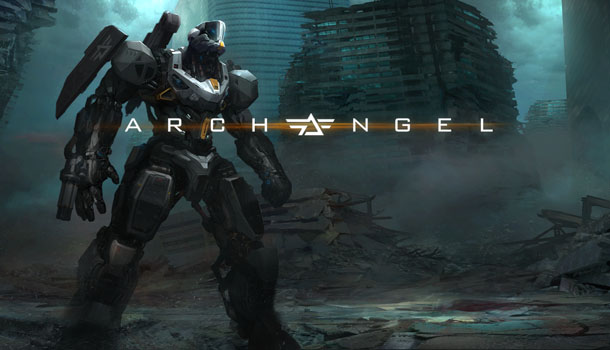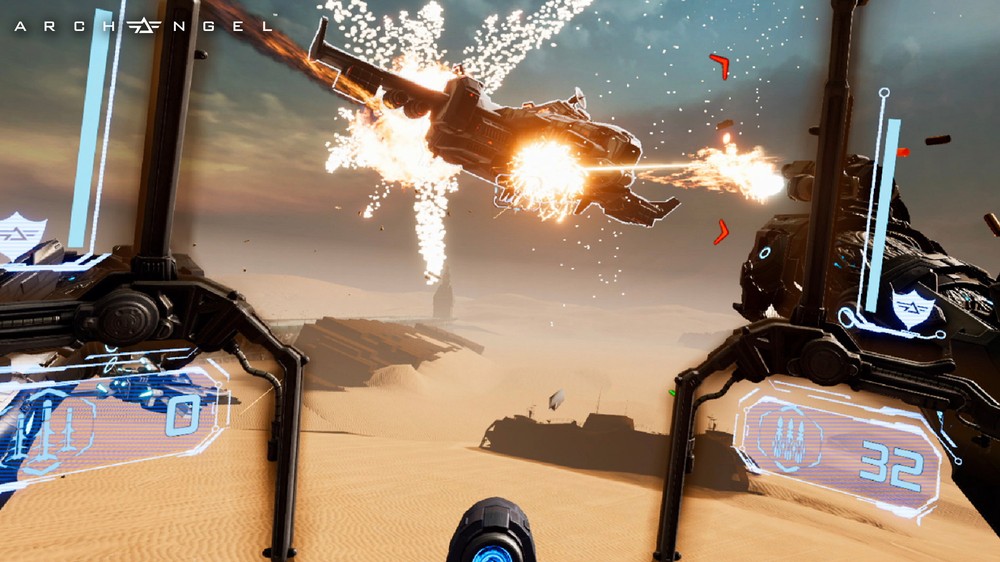Who doesn’t love giant robots? Whether they are MechWarriors, Armored Cores, or even something more than meets the eye you can’t deny the guilty pleasure of skyscraper-sized metal monstrosities wreaking havoc. Some robots are sentient while others are mere metal casings for their human pilots, as is the case in Archangel, the newest giant robot shooter for PSVR.
After a very rocky start I was finally able to play and enjoy this cool new apocalyptic FPS title. Just a heads-up, the DualShock 4 support is totally busted in this game, so when it says “Enhanced play with 2 PS Move controllers” it should say, “PS Move Required”. I wasted 44 minutes of my life trying to get past just the tutorial before I realized there is no way to aim the target reticle using a gamepad, so I couldn’t even punch the right target because I couldn’t move the cursor. Even worse, during this time I had to restart the game twice and with no way to skip the opening cinematic I was forced to watch a rather lengthy opening movie three times. Not a good start.
Things got much better once I went to the options and switched to motion controls. I instantly had precise control of a reticle that now actually moved and was punching and shooting like a robot warrior. The tutorial ended with a surprise attack on my military base – not what you want on “bring your son to work day”. So you, in your experimental mech suit, and a few friends in various ships of their own set off to the futuristic wastelands of Chicago to deal with HUMNX, a large corporation that threatens the free world.
I loved the immersion of Archangel; not just from the engaging storyline that is setup brilliantly with an opening train ride to work where you engage in idle chitchat with your son, but also the complete immersion afforded by VR. The entire opening sequence from the train to the boarding sequence of the giant robot, to the tutorial and ultimately the missions in the outside world never break the illusion that you are in control of a six-story death machine.
The tutorial teaches you the basics and additional mid-mission instructions will help you learn more advanced functions as new abilities and weapons become available. You earn some sort of currency (I don’t think it’s ever explained) that you can spend between missions to upgrade your mech, improving its durability and weapons ability, allowing you to tailor the game to your playstyle.
Gameplay is on-rails when it comes to movement speed and direction, which helps to keep things scripted as far as story and enemy encounters, giving the game a bit of arcade-like predictability, so when you die (and you will die) you know what to expect next time and can be ready for it. Your VR headset is directly linked to your head movement and view within the game while the PS Move controllers give you responsive controls over each arm. Your right arm unleashes powerful machine-gun fire while your left arm can fire a powerful missile or be switched to multi-lock swarm missiles useful for smaller targets, especially flying ones. Each arm also has its own shield generator, which quickly becomes a key part of all the combat encounters.
Rather than full body shields, your mech has these giant circular “Captain America” style energy shields you can summon to deflect incoming fire. The duration of these shields can be upgraded but they are always temporary so you have to get the timing down on when to use one or both shields. It really becomes a strategic art to switch between left and right side protection based on enemy positions and movements. Your AI team is really good about calling out positions, so when you hear “enemy tanks at 2 o’clock” you can be ready to energize that right arm shield. And it gets really tricky when larger enemies start showing up, often in pairs, to attack from both sides. Shields offer a limited area of protection, but you can swing your arm around to block specific attacks to certain areas or summon both to create overlapping protection.
The real trick is to be blocking with one arm and shooting with the other, but since certain enemies go down better with certain weapons you have to be prepared to be block with one arm so you can keep the appropriate weapon arm free to aim. And mixed in to all of this is the occasional punching through bridges or shooting incoming shield-buster missiles out of the air. Missions are fairly lengthy and checkpoints are logically placed so you don’t have to repeat too much of a level, and as mentioned, there is an arcade predictability to the design that makes the game easier with each attempt. I would have enjoyed being able to call out for healing nano-bot support rather than waiting for scripted moments of healing.
The presentation is quite good with a great deal of VR immersion. The overall quality of the game suffers slightly from the limitations of the PSVR. Even the power of my PS4 Pro couldn’t overcome the obvious jaggies and swimmy stair-stepping on straight lines within the landscapes and the HUD. I’m guessing the PC version of this game will clean a lot of this up when it releases in August. Thankfully, the poor aliasing is only a minor annoyance that is lost in all the chaotic and non-stop combat. Subtitles or some sort of volume control would have been appreciated, as it was hard to hear a lot of the com chatter, and I heard almost nothing my mech AI, M1KL had to say.
Archangel is a pretty awesome game in concept and it’s execution on the PSVR is competent if not slightly disappointing when it comes to overall visual clarity. The controls are also an issue. As mentioned, the DualShock 4 is totally busted – not that you would even want to play this game with anything less than twin Move controllers. Having independent control over each arm/shield/weapons is critical to success.
Sadly, it seems the PSVR is becoming home to stripped down or scaled back versions of superior PC games; at least when it comes to third-party devs. PSVR works for a certain type of visual style and a certain type of game, and while Archangel might not be that game, it is still a fun arcade action shooter with enough customization and challenging combat to keep you engaged from start to finish.
















